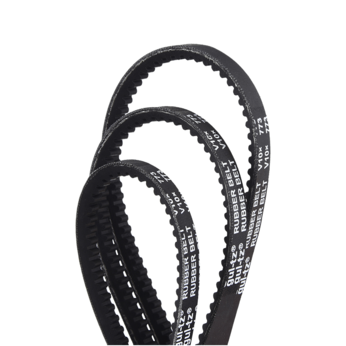What are the advantages and disadvantages of arc-tooth synchronization belts compared with chain transmission
In mechanical transmission systems, arc-tooth synchronous belt and chain transmission are two common and important power transmission methods. The two have their own characteristics in terms of structural design, transmission performance, maintenance, etc., and choosing a suitable transmission method is crucial to improving equipment efficiency and reliability.
Transmission efficiency and stability
The arc-tooth synchronous belt transmission achieves timing transmission through tooth profile meshing, and the power transmission is stable and continuous. The tooth surface curvature design effectively reduces meshing impact, and vibration and noise are significantly lower than chain transmission. The transmission efficiency of synchronous belt transmission can generally reach more than 95%, which is suitable for high-speed operation and high-precision requirements.
Chain transmission is a rolling contact transmission, with contact points being the sprocket teeth and link pin shaft, and the transmission efficiency is usually between 90% and 95%. During the operation, the chain is subject to large vibration and noise due to the rolling of the chain links and the jumping of the chain, and the transmission stability is not as stable as the synchronization belt, especially under high-speed operating conditions.
Load capacity and scope of application
The chain transmission structure is strong and can withstand large impact loads and high torque transmission. Suitable for heavy-load working conditions, frequent start-stop and large load changes. The chain is high in strength and is suitable for power transmission needs in harsh environments.
The load-bearing capacity of arc teeth synchronous belt is limited by the rubber matrix and tooth layer material, and is suitable for medium and light load occasions. By using high-strength fiber layer reinforced synchronous belt tensile strength, arc-tooth synchronous belt can meet a certain range of heavy load requirements, but the overall load-bearing capacity is still lower than that of chain transmission.
Maintenance cost and service life
Chain transmission requires regular lubrication and tension, and the maintenance workload is large. Poor lubrication can easily lead to increased chain wear and chain breakage accidents. The chain is susceptible to dust, silt and corrosion, and its service life is greatly affected by the environment. Chain replacement and maintenance costs are relatively high.
The arc-tooth synchronous belt is made of rubber and fiber composite materials, which does not require lubrication, is easy to maintain, clean and environmentally friendly. The synchronous belt has no metal contact and low operating temperature, which slows down the wear of the tooth surface and the substrate, and has a relatively long service life. It has low maintenance costs and is suitable for modern automated production lines with high requirements for equipment reliability.
Weight and structural compactness
The arc-tooth synchronous belt has a light structure and is much smaller than the chain transmission system. The overall transmission structure of the pulley and the synchronization belt is compact, which is conducive to the miniaturization of the overall design of the equipment. Lightweight helps reduce mechanical inertia and improve acceleration and deceleration response performance.
The chain and sprocket materials are mostly made of steel, with a larger overall weight and a larger volume, which limits the compact design of the equipment. The chain has high rigidity and relatively bulky structure, which is not conducive to the power transmission needs of small and efficient equipment.
Operational environment adaptability
The chain transmission has strong high temperature resistance and corrosion resistance, and is adapted to harsh environments such as high temperature, humidity, dust or oily environments. The chain transmission has superior mechanical strength and impact resistance, which is suitable for heavy industrial environments.
The arc-tooth synchronous belt material is mainly rubber and fiber, which is sensitive to high temperature and chemical corrosion. The working temperature is generally limited to the range of -30℃ to +100℃. High environmental requirements and avoid excessive exposure to oil, fat, strong acid and alkali environment. However, new rubber materials and coating technologies are constantly improving the environmental adaptability of synchronization belts.
Easy to install and adjust
The synchronous belt has a simple transmission structure, easy installation and adjustment, and a flexible design of the tensioning device, which can quickly achieve tensioning force adjustment. The synchronous belt can achieve stepless speed regulation, making it easy to maintain and replace.
The chain transmission is relatively complicated to adjust due to the fixed chain length and sprocket teeth. Chain tensioning requires precise control. Too loose or too tight will lead to reduced transmission efficiency or chain damage. Chain replacement and adjustment require more labor and time costs.
Hot Products
-
 View More
View More
-
 View More
View More
V-belt For Industry
-
 View More
View More
T Type Industry Rubber Synchronous Belt
-
 View More
View More
Toothed wedge belt
-
 View More
View More
Thickened timing belt
-
 View More
View More
Open Timing Belt
-
 View More
View More
Automotive V-belt
-
 View More
View More
Rubber Flat Belt
-
 View More
View More
Ribbed Belt
-
 View More
View More
Synchronous Pulley
-
 View More
View More
Arc tooth industrial rubber synchronous belt
-
 View More
View More
Automotive timing belt

 English
English 简体中文
简体中文
